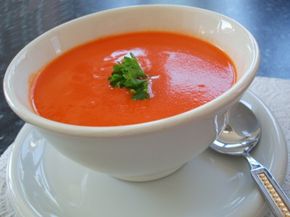Key Takeaways
- To remove soup stains, act quickly to sponge the stain with cold water or a dry-cleaning solvent depending on the material, using techniques like blotting, sponging and applying a wet or dry spotter as necessary.
- For washable fabrics, soaking in a mixture of warm water, liquid detergent and ammonia can help lift the stain, followed by rinsing and laundering.
- On hard surfaces and non-washable materials, wiping with a cloth dipped in warm sudsy water or a specialized cleaning solution, then rinsing and drying usually removes the stain.
Soup is delicious. Whether you slurp it or sip it, the stuff is good eats. However, due to its liquid form, it is also very easy to spill. Here we'll address how to remove meat-base soups from a variety of household surfaces.
How to Remove Soup Stains From:
Acetate, Carpet (synthetic or wool), Fiberglass, Rayon, Silk, Triacetate, Wool
Advertisement
Treat the stain as soon as possible. Set meat stains can be extremely difficult to remove. Sponge (the method of using a dampened pad to apply light strokes, moving outward from the center of the stain) the stain with cold water. If fresh, this should remove it. If any stain remains, apply a wet spotter and a few drops of ammonia (omit ammonia on silk and wool). Cover with an absorbent pad dampened with the wet spotter. Let it stand as long as any stain is being lifted, changing the pad as it picks up the stain. Keep the stain and pad moist. Flush (the method of applying stain remover to loosen staining material and residue from stain removers) with cool water, making sure to remove all traces of the ammonia.
How to Remove Soup Stains From:
Acrylic Fabric, Cotton, Linen, Modacrylic, Nylon , Olefin, Polyester, Spandex
Fresh meat stains usually can be removed by a thorough washing in cold water. If any stain remains, soak it in a solution of 1 quart warm water, 1/2 teaspoon liquid detergent, and 1 tablespoon ammonia for 15 minutes. Tamp (the method of bringing a brush down with light strokes on stained durable fabrics and materials) or scrape (the method of using a dull tool to gently lift off excess solid or caked-on stains), blotting occasionally with an absorbent pad. Continue as long as any stain remains. Rinse well with water, making sure to remove all traces of ammonia.
How to Remove Soup Stains From:
Acrylic Plastic, Alabaster, Aluminum, Asphalt, Copper, Cork, Linoleum, Marble, Paint (flat or gloss), Plexiglas, Polyurethane, Porcelain, Stainless Steel, Vinyl Clothing, Vinyl Tile, Vinyl Wallcovering
Wipe stain with a sponge dipped in warm sudsy water. Rinse thoroughly and wipe dry.
How to Remove Soup Stains From:
Bluestone, Brick, Concrete, Flagstone, Granite, Limestone, Masonry Tile, Sandstone, Slate, Terrazzo
Wipe up the stain with a sponge dipped in cool water. If any stain remains, wash or brush (the method of using a stiff-bristled brush to sweep staining material up onto a piece of paper) the stain with a solution of washing soda or detergent (not soap) in warm water. Rinse well and allow to dry.
How to Remove Soup Stains From:
Carpet (synthetic or wool)
Blot up as much liquid as you can and sponge the area immediately with cool water. This should remove any stain, but if one remains, apply Spot Shot Carpet Stain Remover, Stain-X Carpet Stain Remover, or Up & Out (do not use this on wool) according to the package directions. If the stain persists, mix 1 teaspoon mild detergent in 1/2 warm water. Add a small amount to the carpet and blot the liquid. Take care not to force the stain further into the fibers. Continue until no more stain is removed. Flush thoroughly with water. Place an absorbent pad over the area and weight it down. When no more liquid is drawn out, remove the pad and allow it to air dry thoroughly.
How to Remove Soup Stains From:
Leather, Suede
Blot up what you can and follow with a leather cleaner, Tannery Vintage Leather Cleaner & Conditioner, according to package directions. Or mix dishwashing detergent in hot water and swish to make a great volume of suds. Dip a cloth in only the foam and wipe the area. Wipe dry with a clean dry cloth. On leather only, follow with Tannery Vintage Leather Cleaner & Conditioner or Fiebing's Saddle Soap.
How to Remove Soup Stains From:
Wood
Wipe the stain with a clean cloth dipped in warm sudsy water. Rinse with a damp cloth and wipe dry. Polish or wax as soon as possible.
Now that we've established how to get meat-based soup stains out of everything from wool to wood, let's continue reading to discover how to remove stains caused by vegetable-based soups.
Advertisement
